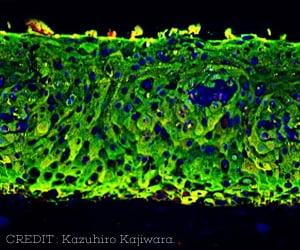Ionic skins (I-skin) responds like a human skin in terms of electrical and optical signaling. This brings about new opportunities for detecting damage in robots and prosthetic devices.

‘Ionic skins (I-skin) responds like a human skin in terms of electrical and optical signaling. This brings about new opportunities for detecting damage in robots and prosthetic devices.’





Robots and prosthetic limbs don't have these warning signs, which could lead to further injury. Now, researchers reporting in ACS Applied Materials & Interfaces have developed an artificial skin that senses force through ionic signals and also changes color from yellow to a bruise-like purple, providing a visual cue that damage has occurred.
Scientists have developed many different types of electronic skins, or e-skins, that can sense stimuli through electron transmission. However, these electrical conductors are not always biocompatible, which could limit their use in some types of prosthetics.
In contrast, ionic skins, or I-skins, use ions as charge carriers, similar to human skin. These ionically conductive hydrogels have superior transparency, stretchability and biocompatibility compared with e-skins.
Qi Zhang, Shiping Zhu and colleagues wanted to develop an I-skin that, in addition to registering changes in electrical signal with an applied force, could also change color to mimic human bruising.
Advertisement
In testing, the gel showed changes in color and electrical conductivity when stretched or compressed, and the purple color remained for 2-5 hours before fading back to yellow.
Advertisement
Bending or stretching caused a change in the electrical signal but not bruising, just like human skin. However, forceful and repeated pressing, hitting and pinching produced a color change.
The I-skin, which responds like human skin in terms of electrical and optical signaling, opens up new opportunities for detecting damage in prosthetic devices and robotics, the researchers say.
Source-Eurekalert














